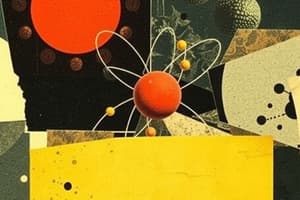Podcast
Questions and Answers
What is the main component of an atom's nucleus?
What is the main component of an atom's nucleus?
- Neutron (correct)
- Electron
- Subatomic particle
- Proton
What is the charge of a proton?
What is the charge of a proton?
- Variable
- Neutral
- Negative
- Positive (correct)
Which subatomic particle has the least mass?
Which subatomic particle has the least mass?
- Electron (correct)
- Nucleon
- Proton
- Neutron
How do the number of protons in an atom compare to the number of electrons?
How do the number of protons in an atom compare to the number of electrons?
What is the main function of neutrons in an atom?
What is the main function of neutrons in an atom?
Where are electrons located in an atom?
Where are electrons located in an atom?
What is the atomic number of an atom?
What is the atomic number of an atom?
How is the mass number of an atom calculated?
How is the mass number of an atom calculated?
What does the difference between the mass number 'A' and the atomic number 'Z' of an atom give?
What does the difference between the mass number 'A' and the atomic number 'Z' of an atom give?
In the given atomic structure, if the number of protons is 13, what is the atomic number of the element?
In the given atomic structure, if the number of protons is 13, what is the atomic number of the element?
What is represented by the symbol 'A' in the context of atomic structure?
What is represented by the symbol 'A' in the context of atomic structure?
If an atom has 8 protons and 9 neutrons, what is its mass number?
If an atom has 8 protons and 9 neutrons, what is its mass number?
What does 'Z' represent in atomic structure?
What does 'Z' represent in atomic structure?
If an atom's mass number is 40 and its atomic number is 20, how many neutrons does it have?
If an atom's mass number is 40 and its atomic number is 20, how many neutrons does it have?
What is the specific number of protons present in the nucleus of every atom called?
What is the specific number of protons present in the nucleus of every atom called?
What is the sum of protons and neutrons in the nucleus of an atom called?
What is the sum of protons and neutrons in the nucleus of an atom called?
What does the difference between the mass number 'A' and the atomic number 'Z' of an atom give?
What does the difference between the mass number 'A' and the atomic number 'Z' of an atom give?
The number of protons in an atom is also equal to the number of ________ present in the atom.
The number of protons in an atom is also equal to the number of ________ present in the atom.
Which term represents the number of protons and neutrons in the nucleus of an atom?
Which term represents the number of protons and neutrons in the nucleus of an atom?
What is represented by the symbol 'A' in atomic structure?
What is represented by the symbol 'A' in atomic structure?
What does 'N=A-Z' represent in terms of atomic structure?
What does 'N=A-Z' represent in terms of atomic structure?
The given atomic structure represents which element?
The given atomic structure represents which element?
Flashcards are hidden until you start studying
Study Notes
Atomic Structure
- The main component of an atom's nucleus is protons and neutrons.
Protons
- Protons have a positive charge.
- The number of protons in an atom is equal to the atomic number (Z).
- The number of protons in an atom determines the element of an atom.
Neutrons
- Neutrons have no charge.
- The main function of neutrons in an atom is to stabilize the nucleus.
- The number of neutrons in an atom can vary, leading to different isotopes of the same element.
Electrons
- Electrons have a negative charge.
- Electrons are located in energy levels outside the nucleus.
- The number of electrons in an atom is equal to the number of protons (atomic number) in a neutral atom.
Atomic Number and Mass Number
- The atomic number (Z) of an atom is the number of protons in the nucleus.
- The mass number (A) of an atom is the sum of protons and neutrons in the nucleus.
- The difference between the mass number (A) and the atomic number (Z) of an atom gives the number of neutrons (N=A-Z).
Symbolic Representation
- The symbol 'A' in atomic structure represents the mass number (sum of protons and neutrons).
- The symbol 'Z' in atomic structure represents the atomic number (number of protons).
- N=A-Z represents the number of neutrons in an atom.
Studying That Suits You
Use AI to generate personalized quizzes and flashcards to suit your learning preferences.



